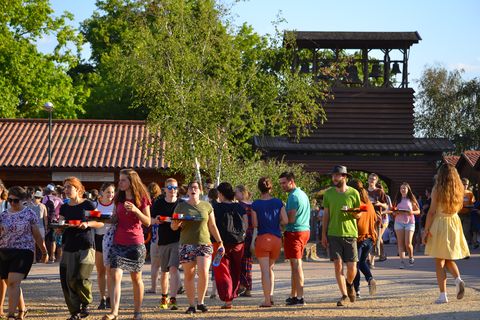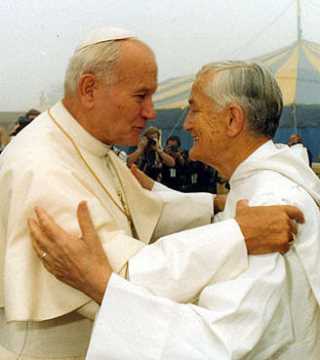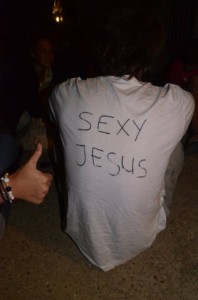That’s how the Letter from Chile begins, written in 2010 by Brother Alois.
And truly, a joyful heart is really life! And the two weeks in Taizé, France, were very joyful.
This blog entry will contain two things: Taizé in general for those who are not very familiar with Taizé and also about my personal experiences for these two weeks.
In august 1940, when World War II was covering the world with darkness and parts of France were occupied by Germany, a 25-year-old man by the name of Roger took his bicycle from Switzerland to eastern France. He arrived to a small village by the name of Taizé and stayed there. He wanted to help those suffering from the war, just like his grandmother had done during World War I. In Taizé, he and his sister Genevieve offered shelter for many Jews. However, they were warned by a friend in the military that their activities had been found out and he told them to leave at once. They left for Geneva, were Roger met those that would become the first brothers of Taizé. In 1944, they could return to Taizé. More came to join the men’s group in Taizé and on Easter Day 1949 there were seven of them who commited themselves to celibacy and a life in great simplicity.
For a reason that remains mysterious to everyone, people started visiting Taizé. In the beginning, the brothers sent them away – thinking that the guests would only harm their community. But for a reason that remains even more mysterious, people continued to come. And so the brothers thought: “Maybe we can do something good from all this”. And so, the meetings of Taizé started.
Taizé is a christian community but Taizé welcomes everyone. There is no one asking you when you arrive: “Do you believe in God?”. There is no one telling you what you should believe either. But what most people do when they are in Taizé is to reflect about their faith and their life in general. What kind of life do I want? What part of Taizé do I want to bring with me home? And also, people live in the moment, most of them are joyful and people share their experiences of life with others. All these things are optional of course. Choose the parts that you like, but I recommend all parts. Together, they make life. That is what I think Taizé is about: Reflection, joy and sharing.
Skipping ahead 30 years or so… after the small village church became too small for all the visitors and the Church of Reconciliation was built and after it was expanded and after the pope John Paul II visited Taizé in 1986 and saying to all the young people there that “Like you, pilgrims and friends of the community, the pope is only passing through. But one passes through Taizé as one passes close to a spring of water. The traveller stops, quenches his thirst and continues on his way.”…
Every week in Taizé there could be thousands of people arriving to stay for one week. People come from very diverse backgrounds: Europe, Asia, South America, Africa, Australia, North America but everyone stays in Taizé under the same conditions. In Taizé we are all humans. Everyone lives together in a very small area and Taizé is not like your ordinary hotel (you live in tent or a simple “barrack” dormitory), the visitors who come needs to help with some practical work to make life in Taizé work. There are working teams for everything from cleaning the toilets to working in the non-profit store Oyak (my personal favorite!). A swedish girl said that Taizé is like a festival, but instead of a festival with many different concerts, everyone is kind of here to see the same concert.
The timetable in Taizé is very structured, the day starts with morning prayer at 8.15 (unless you are very sleepy and miss the morning prayer) and breakfast is at 9. Shortly after breakfast, you either go to your working team or go to a “Bible introduction” where one of the brothers of Taizé tells you about some part about the bible that will tell you something about life in general. After the short bible introduction you meet with a group with people from different countries, you never know who you are going to end up with but they’re usually lovely people (and there is the possibility to change group if things don’t work out).
On exactly 12:22, the bells start to ring and it’s time for midday prayer (when the bells has stopped ringing after 10 minutes), followed directly by lunch (approximately 13:00). For the afternoon, you either go to working team or to your discussion groups. There is usually a couple of hours each afternoon for free time, where you can go (by yourself or with friends) to the source – a peaceful area which is a place for silence and reflection. Tea + COOKIE at 17:00 and, on tuesday to saturday there’s optional workshops with different themes (usually quite interesting!) at 17:45. There are actually some workshops where they don’t mention God, Jesus, or the Bible at all – they are just about life in general. Evening meal is at 19:00 and on 20:27 the bells start to ring again for 10 minutes and it’s time for evening prayer. But don’t worry about all these times. When you are in Taizé, after two days you will know what it is time for.
Does prayer three times a day sound much? Well… the prayers in Taizé is not really like at home – wherever your home is. The prayers in Taizé is a time for stopping your ordinary life and taking a break for about 30-40 minutes. Each prayer has approximately 10 minutes of silence in it. In the beginning, it may seem a bit much because you’re quite stressed but after a couple of times you enjoy the silence. Here’s an example video of a prayer in Taizé, this is from a saturday evening. All saturday evenings in Taizé have these candles. Think about that if you see that the time is around 21:10 on a saturday evening.
And for the times you’re not in church, there’s always something else to do, or some people to meet – if you want to. Everywhere you go you see people. On my second week this year, I chatted with a swedish guy I met on my bible introduction during tea time. Then suddenly around six or seven girls came sitting right next to us. I asked them were they were from and started speaking some Lithuanian with them (that’s where they were from!), the parts I know – in Taizé you always learn how to say short phrases in many different languages. I and the lithuanians then started chatting with some portuguese and french people who were singing. Then suddenly a girl from Latvia and then later a girl from the Netherlands joined. And before I knew it, I had met some of the most amazing people in my life. Many of these people I also met later during the week and talked about lots of things.
In the evening, after the evening prayer, most people gather at Oyak – the non-profit shop in Taizé. People buy food, drinks, snacks, toothbrushes and other stuff they want or need. And before you know it, there’s someone bringing a guitar, sits down and starts to sing “Para bailar la bamba”…
Let me tell you about one of my experiences in Oyak during my first week in Taizé this year, I was chatting with some Dutch guys I met during the Taizé-meeting in Rotterdam. I said to them that I wanted to meet Lithuanians, because I hadn’t met anyone yet that week. So we asked some girls where they were from and yeah, they were Lithuanians!! We talked about the ordinary Taizé-questions (“Is this your first time in Taizé?” and others) when there were people with “Free Hugs” signs walking around Oyak, some of us hugged them of course and I told the Dutch and the Lithuanians that I also wanted such a sign. The Lithuanian girls came up with the brilliant idea that I have a white t-shirt, let’s write on that! So they writed “Free Hugs” on the front and one of the girls said that I should write “Free Fucks” on the back. I disagreed on that, saying that it should say “Fucks, 10 euro”. And then the girls started to haggle about the price saying that “No, we only pay 2 euro!”. I told them that I wasn’t so cheap. So, they started thinking about something else for me. They thought I looked a little like Jesus, so they started calling me “Sexy-Jesus” and that’s what ended up on the back of my t-shirt.
So, one question that many friends asks me about: Why? Why do I go to Taizé? Why do I go to Taizé once a year?
And the question I always ask myself: Why do so many people, from all around the world, go to Taizé?
The second question, I am unable to answer. I’ve been asking that question for many years, and it all remains a mystery – just like the mystery about why people started coming to Taizé.
What I can answer is the first question. Why do I go to Taizé?
What made me go to Taizé the first time was that I have always wanted to visit France, having studied french for five years I needed to practice it also. A monastery in France sounded very interesting. However, it wasn’t at all what I imagined it would be. First of all, I would have had more use for German if I would have known it, because the first week I ever was in Taizé, more than half of the approximately 1500 visitors were Germans – most of the others were Swedish. And that’s why I don’t go to Taizé in June anymore. I prefer August, when there’s usually 4000 people from 80 different countries. Even though there were many Germans, Swedes and not much people in general, I was still surprised in a very positive way. There was something special about that place.
Taizé for me is nowadays a place, and a kind of people, of trust and joy. Taizé is a place for taking a break from ordinary life and being reminded about what is really important in life. That’s not your computer, or mobile phone. It is also a time for meeting people. It is a time of pure happiness. Everything is for a brief moment in time exactly the way it is supposed to be – especially this year’s visit was like that. Every day you have opportunities to meet new people, learn about some interesting connection between the bible and the real life, or have an insight about “This is the way it is!”. One thing I love the most about Taizé is the contrasts. One minute you’re sitting in the church singing those peaceful Taizé-songs. The next minute you are standing in the foodline for lunch and people are singing happy songs in all kinds of languages, or playing games or simply doing what Taizé-people do best: Meeting new people. Also, in one minute you could be down at the peaceful source thinking about life, a few minutes later you could meet the most beautiful person you’ve ever seen, or playing games with crazy funny people from anywhere, or be a part of people building a circle. You ask “Why make a circle?” I ask: “Why not?”. If you’re not happy with that answer, I say that it’s because they can!
Some short events that happened in Taizé this year:
When I and Marta from Latvia was standing in the dish-line we started to gather the dishes for everyone else as well, seeing how much we could carry, and there was a girl who we took the dishes for that thanked us for saving her life! That must have been the easiest life to save ever!
This year, I went to a workshop about relationships. “What freedom is there in our relationship with others? Sharing and practical exercises”. It made me realize that people always have the right to say no. Even if some people maybe say it too often and some people too seldom.
Lunch on Friday the first week was in silence, in solidarity with people suffering from hunger in Somalia, Kenya, Ethiopia, and also in North Korea. The week before, apparently there was the same thing but for the victims of the attacks in Norway. Usually during lunch, there’s a lot of noise, but this day it was very quiet during lunch. An incredible experience.
I did meet two persons who were going to study in Sweden this coming year: Kristina from Lithuania in Uppsala, and Shin from South Korea in Karlstad. I wish you a nice stay in Sweden, girls!
On Sunday, when the first week changed into the second week, people were leaving but I was staying. I was a part of the welcome team, around 250 people were in one single day welcoming 3773 people to Taizé. I had never been part of the welcome team before, it was a nice experience!
When I was working in Oyak one evening, selling bottles, I asked a customer where he was from (This question could be in “Taizé Guide To Meeting New People: Chapter 1” if there existed such a thing), he was from the Netherlands. So I said to him: “Nietmachine!” Which is one of the very few words I know in Dutch (it means “Stampler” by the way). And then he laughed and asked me where I was from and told me, in Swedish: “Häftapparat!” which of course is the Swedish word for nietmachine.
One Lithuanian guy who worked with me in the Welcome Team said to me in Swedish: “Du ser ut som en motorbåt!” (You look like a motorboat). Where do people learn stuff like this? Taizé of course. I withdraw the question.
A Latvian girl I met, Marta, had hitchhiked all the way from Latvia, first to Geneva and spending a few days there, then all the way to Taizé. She and her friend went in the same car all the way from Latvia to Poland! She had also some years ago hitchhiked to Sweden, staying with some people in Gothenburg who she came in contact with on couchsurfing.org. That’s awesome!
There were some groups from Africa, mostly from Rwanda, performing dances and singing:
There were also people from different countries of Latin America (Mexico, Honduras, Guatemala, Brazil, Peru, and others…):
I hope that I have answered most of your questions about Taizé and my two weeks there this year.
I also hope that you are even more curious about this place, whether you’re a believer or non-believer.
In Taizé, we are all humans.
“Over-accumulating material possessions kills joy. It keeps us trapped in envy. Happiness lies elsewhere: by choosing a simple lifestyle, working not just for profit but to give meaning to life, sharing with others, everyone can help create a future of peace. God does not give a spirit of timidity but a spirit of love and inner strength.”
– Brother Alois, Letter from Chile




Det var ett inlägg som heter duga! Jag blir alltid glad av dina inlägg…
Jag blir alltid glad av dina inlägg… 